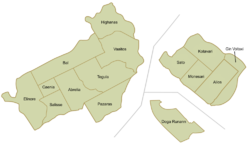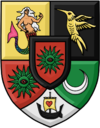Verona
Verona | |
|---|---|
Region | |
| Region of Verona | |
| Mottoes: Myinëth Pashqariq im rëdon Pashqaras (Pashqar: "We live for Verona and we will die in Verona") | |
 | |
| Country | |
| Admission | 20 October 2012 |
| Capital | Tegula |
| Government | |
| • Type | Autonomous region |
| • Body | Regional Council |
| • Governor | Petyr Cohen (Democrat) |
| Area | |
| • Total | 0.00008494 km2 (00 sq mi) |
| Population (2015) | |
| • Total | 25 |
| • Density | 290,000/km2 (760,000/sq mi) |
| Time zone | UTC-4 (VST) |
| Languages | Sabian |
The Region of Verona (Sabian: akurói veronann), also sometimes known poetically as Pashqaria (baškara) is one of the five first-tier administrative divisions of Sabia and Verona, and alongside the Sabia and Lycem, one of the three regions comprising Sabia and Verona's Northern Territories. Alongside Sabia, it's one of the two original regions of the Kingdom that give the nation its name. It's divided into two prefectures and one dependency: Abrelia, Tegula and the Dependency of Pazaras. Tegula serves as the region's capital.
The region's population is either regarded as Veronans or as Pashqari. Both terms originated in the early days of Sabia and Verona. Although there are no ethnic groups in Sabia and Verona, a vast majority of population in Verona regard themselves as "Pashqari" rather than as Veronans. For a long time, the Pashqari had their own language and culture. The Pashqar language was declared extinct in 2015, and for the most part the Pasqhari culture has blended with the rest of Sabia and Verona's culture; in modern days, it's considered inseparable from the culture and traditions of Sabia and Lycem.
History
Foundation and early era
The region was founded in October 2012 along with its neighbouring Sabia, and from the beginning it was part of Sabia and Verona as an entity. When it was founded, Verona counted with five municipalities and almost no population, ranging from two or three inhabitants to no population at all. Verona's population issues were present until the government of Osez Kóvérsz implemented the associated citizenship, when a large group of immigrants to Sabia and Verona were enlisted as citizens of Verona, living in Sabia with the condition of staying in the Veronese region for at least five days each month. Veronans that decided to stay in Verona rather than living in Sabia would later be known as Pashqaris, and would develop their own language and culture. The Pashqar langauge is not official in Sabia and Verona however, although it has been recognized by the Government. With the rapid increase of population in Verona, the Legislative Courts agreed to draw new borders for the intern subdivision of Verona. Its five municipalities became two, Tegula and Abrelia.
Modern days
When Sabia and Verona became a transitioned into a province of the Federal Union of Juclandian Lands, Verona was granted its own government, composed of a Lt. Governor and a Provincial Council of ten members, five from each of Verona's prefectures. In August 2014 the southern parts of Abrelia and Tegula were united into the Special Integrated Territory of Pazaras.
When the Haronos Plan went underway in 2015, a large portion of Verona's population left the region to found the city of Alios in what would become the Southern Territories. The adoption of a new constitution meant Verona was granted its own Governor and its own autonomous Parliament, the Legislative Assembly, with more powers than the region had ever counted with before. On 2 September 2015, Petyr Cohen, new leader of the Left Alliance, was elected Governor of Verona.
Government and administration
As part of the Northern Territories of Sabia and Verona, the Region of Verona is relatively autonomous in its own affairs. It elects its own Governor and Legislative Assembly, both of which serve for five year terms. Before the introduction of the 2015 Constitution and the foundation of Alios, the Region of Verona was administered by a Lieutenant Governor and a Provincial Council. Nowadays, due to the new constitution, the region is considerably more independent from the national legislature and its laws.
There is a downside to this however, as the new constitution also barred citizens of Sabia and Verona living in the Region of Verona from the right to vote and participate in nationwide elections. Citizens in the Region of Verona cannot be candidates for the national parliamentary elections, and cannot be members of any of any institutional organ of the Sabioveronese state. This means Verona is not represented in the Parliament.
The current Governor of Verona is Petyr Cohen of the Democrats. The last legislative election was held on 2 September 2015. The Legislative Assembly of Verona consists of 10 members.
Administrative divisions
As a region, Verona is a first-tier administrative division and it's governed by a democratically elected Governor who presides over the Legislative Assembly.
The Region comprises two prefectures:
- The Tegula Prefecture
- The Abrelia Prefecture
And a Dependency, the Dependency of Pazaras.
List of governors
| # | Governor | Elected | Term of office | Party | Notes |
|---|---|---|---|---|---|
| 1 | Apollo Cerwyn | 2014 | 23 February 2014 – 4 August 2015 | Bakinn | "Lieutenant Governor" as per the Constitution of 2014 |
| 2 | Rubén D. Hernández | — | 4 August 2015 – 3 September 2015 | Independent | Acting Lt. Governor |
| 3 | Petyr Cohen | 2015 | 3 September 2015 – present | Democrat |



